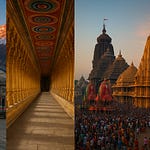Nestled in the serene lap of the Dhauladhar ranges of Himachal Pradesh, along the banks of the Gomati river, lies a temple whose walls echo with chants, myths, and divine energy – the Baijnath Temple. This sacred abode of Lord Shiva, worshipped here as Vaidyanath or the Divine Physician, is not merely a religious site; it is a place where history whispers, faith breathes, and spiritual energy pulsates with ancient vitality.
This is not just a temple. It is an unbroken sanctum of worship for over 800 years, a monument of Nagara architectural brilliance, and a locus of mystical healing powers. From its mysterious foundations to the ritualistic vibrations of daily aarti, Baijnath Temple is an experience that cannot be merely visited—it must be absorbed.
Historical Origins & Foundation: The Birth of a Shiva Shrine
The temple was constructed in 1204 AD by two local merchants named Ahuka and Manyuka, devoted followers of Lord Shiva. Their intention was not merely to build a place of worship, but to establish a tirtha—a spiritual crossing point between the earthly and the divine.
Though the current temple was built in the 13th century, legends suggest that a Shiva Linga at this site existed long before the stone structures rose around it. According to regional lore, this site is one of the Dwadasha Jyotirlingas (Twelve Radiant Lingams), where Lord Shiva appeared in his healing form.
The name Baijnath comes from “Vaidyanath” – a title meaning “Lord of Physicians,” connecting the temple with miraculous healing powers and spiritual restoration.
Architectural Grandeur: The Eternal Silence of Stones
Baijnath Temple is an exemplary structure of the Nagara style of North Indian temple architecture. Its defining features include:
A majestic shikhara (spire) that soars into the sky like a stone hymn to divinity.
Intricately carved outer walls with depictions of gods, goddesses, and celestial beings from Hindu scriptures.
A sanctum (garbhagriha) where the Shiva Linga resides, unchanged and undisturbed since its placement centuries ago.
Mandapas with sloped roofs, an architectural adaptation to Himachal’s snowy climate.
The temple’s foundation stone contains Sanskrit inscriptions detailing the history and patrons of the temple.
This timeless structure is built from limestone and sandstone, and despite centuries of earthquakes, weathering, and wars, it remains unshaken—a testament to divine will and human devotion.
Mythology and Mystery: The Enigma of Vaidyanath
One of the greatest mysteries of Baijnath Temple lies in its association with the Ravana legend. As per beliefs:
Ravana, the king of Lanka and a devout Shiva worshipper, meditated and offered his ten heads to Lord Shiva at this very site. Pleased, Shiva appeared as Vaidyanath to heal and bless him with unmatched wisdom and power.
Some traditions even suggest that Ravana carried a Shiva Linga from here to Lanka, but was instructed never to place it on the ground. When he did, the Linga became immovable. Similar myths connect the site to the Shiva Jyotirlinga circuit, though its inclusion remains debated among scholars.
This powerful association with Ravana adds a layer of Tantric and esoteric mysticism to Baijnath Temple, distinguishing it from more orthodox Shiva temples.
Rituals and Puja: Sacred Rhythms of Devotion
The temple follows a strict daily puja regimen, maintained unbroken for centuries. The primary rituals include:
Morning Abhishekam – Anointment of the Shiva Linga with water, milk, honey, curd, and ghee.
Bhasma Aarti – Offering sacred ash (vibhuti) to the Linga, a rare ritual believed to align devotees with cosmic energy.
Sandhya Aarti (Evening Aarti) – A spiritually uplifting experience where conches, bells, and Vedic hymns fill the air.
Rudra Abhishek – Performed on Mondays and during the Shravan month, this ritual involves 108 names of Lord Shiva chanted during an elaborate anointment ceremony.
Maha Shivratri Puja – The most important annual festival, celebrated with all-night vigils, mass chanting, lighting of diyas, and fasting.
Devotees also perform Parikrama (circumambulation) of the temple, often barefoot, with prayers on their lips and faith in their hearts.
Bhajans and Spiritual Music: Voices of the Devotees
Every evening, after the aarti, Shiv Bhajans fill the temple complex. These bhajans are not mere songs—they are ancient mantras, naad brahma (divine sound), believed to purify the environment.
Popular bhajans sung include:
“Shiv Tandav Stotram” – a hymn attributed to Ravana himself
“Om Namah Shivaya” chants in collective rhythm
“Bam Bam Bhole” during festivals and special pujas
These musical offerings create a transcendental space where devotee and deity become one.
Spiritual Significance: A Portal to Higher Consciousness
Baijnath Temple is not just known for its healing Shiva Linga, but for being a powerful energy center. Devotees often report:
Relief from chronic ailments
Mental clarity and emotional peace
Dreams and visions post darshan
Healing of karmic patterns and ancestral blocks
The temple is also considered an ideal site for meditation, mantra chanting, and spiritual retreats.
Mystics believe that the convergence of earth element (stone), water (Gomati river), and ether (mountain air) at Baijnath makes it a powerful triveni (spiritual junction).
Visiting Baijnath: Travel & Devotional Journey
📍 Location
Baijnath Town, Kangra District, Himachal Pradesh
Altitude: ~1,130 meters (3,700 ft) above sea level
🛤️ How to Reach
By Air: Nearest airport – Gaggal Airport, Kangra (~50 km)
By Train: Baijnath Paprola Railway Station is the closest.
By Road: Accessible via Dharamshala, Palampur, and Bir-Billing by car or bus.
🕒 Temple Timings
Open: 6:00 AM – 9:00 PM
Puja/Aarti: Morning (6:30 AM), Evening (7:00 PM)
🧘 Best Time to Visit
March to June – Pleasant weather
Mahashivratri – Major spiritual gathering
Shravan Month (July–August) – Special Shiva rituals and Rudrabhishek
Nearby Attractions for Pilgrims & Travelers
Bir-Billing: World’s 2nd best paragliding site – adventure meets devotion
Palampur Tea Gardens: Nature's delight
Andretta Artist Village: Blend of spirituality and creativity
Tashi Jong Monastery: Tibetan spiritual center nearby
Devotee Testimonials: Faith in the Divine Healer
“I came with chronic back pain and left with relief I couldn’t explain. I wasn’t just healed physically, something inside me changed too.” – Devika Sharma, Delhi
“Sitting in silence at Baijnath Temple was more powerful than any meditation retreat. I felt Shiva.” – Anand Iyer, Mumbai
“This temple doesn’t shout. It sings to your soul in a quiet language.” – Rina Das, Kolkata
Where Time Stands Still, and Faith Moves Mountains
Baijnath Temple is more than a monument. It is a living, breathing Shiva Kshetra that binds together centuries of myth, sculpture, music, and meditation into one eternal moment.
For seekers, it is a threshold to higher consciousness. For devotees, it is Shiva’s healing presence. For historians, it is an architectural jewel. And for travelers, it is a gateway to India’s spiritual Himalayas.
Come not just to see. Come to feel, pray, heal, and become one with the rhythm of the cosmic drum—Damaru of Mahadev.










